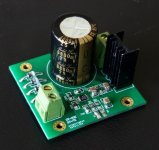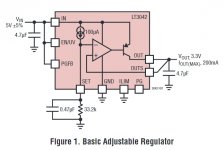Hi Guys I received the Aliexpress built up unit - CRAP. Plugged in & did not work. crappy 12 volt transformer. Reported fault to Aliexpress with photo's they rejected claim as I should have supplied video (don't own, and don't want to own smart phone, so no can do)
The board works though when I connect up a 12 VDC wall wart but have not tried with my phono amp.
First time I have used Aliexpress & it will be the last, no such hassles with E/Bay.
Cheers
The transformer is the weakest point just as I assumed. Normally it is the most expensive part in a PSU so that is where money can be lost. Or gained... It is not the fault of Aliexpress but it is the seller at fault. A careful examination of the pictures made me conclude the findings I stated earlier. The board itself is fine. Not everyone in the world can build safe and well built stuff. It is better to be a critical customer and not let a low price fool you.
Let a friend with mobile phone make a video and get your money back. Stuff like this should not be sold!
Last edited:
What Jung and Marsh were referring to were capacitors in the audio signal path, not power supply capacitors. There are very good reasons that certain types of caps are specified for use with voltage regulators, such as to prevent a regulator from turning into an oscillator. Same type of thing for caps used to decouple IC power pins. Caps that can affect audio quality are those used for things like signal coupling, audio signal filtering, dac I/V converter feedback caps, etc.
Did I say otherwise? I didn't say you should use expensive film caps for power supplies decoupling, but I do not trust tantalum types. Once I had an Asus motherboard where tantalums caught fire! Same thing happened on a pair of signal input tantalums on a preamp.
However, some capacitor types, like low ESR electrolytics, do not like certain places on a supply or with some regulators.
In addition, some ceramic caps are great for audio sound quality and some are terrible when used in the signal path. COG and NPO types are very high fidelity and as good as any cap out there for audio signal use. Ceramics such as X7R and Z5U are for power supply decoupling, not for the audio signal path.
Agreed on the X7R and Z5U should just be used on power supplies decoupling, but I doubt any ceramic type, even COG or NPO, can equal the audio quality of a good film type, particularly polystyrene if you can find it, or polypropylenes. Sometime I may try them and change my opinion.
EDIT: The above is kind of the short explanation. It can get more complicated in some cases when there are multiple factors acting at once. Unfortunately, there is no simple rule that polystyrene is always better for any and all applications, or anything like that.
Polystyrenes are the best for audio signal filtering, and nothing else.
Tantalum capacitors were unreliable long ago. Nowadays every mobile phone has them. The technology has improved a lot. The bad reputation comes from the so called drop types. These were notorious for catching fire, especially when used directly on power rails. It is still advisable to derate tantalums i.e. to use a 35V type in a circuit where voltage will never be higher than 25V. 20 Years ago I would not touch them except when I replaced them for normal electrolytic caps, nowadays I am quite fond of them because of their excellent specifications.They are one of the few that have values with different ESR variations. So 47 µF 25V in let's say 50 mOhm but also in 100 mOhm ESR version.
The mining of the coltan ore is in many dubious countries though. It is a fact that countries paid for weapons with coltan. I am not aware what the situation is now. Considering the fact that mobile phones are produced in extreme numbers I guess the situation must have changed. Or...
Polystyrene caps are hard to find and they were quite fragile and moist sensitive. Hardly a cap to advise to others as production was stopped long ago just like that of the excellent MKC caps.
Back to LT3042...there are way too many threads about capacitors.
LT3042 and LT3045 were introduced recently while LM317 is a design from 30 years ago (or more). Then low ESR caps did not exist ! It is a bit sour that at the end of the analog era the best regulators are invented Recent regulators are almost all of the LDO type and the ability to withstand the now standard low ESR ceramic caps is incorporated in their design. The industry and the customers like ceramic caps because of their small size and price so that is what becomes standar and that is why attention went to improving those. Modern ceramic caps do not resemble the old disc type caps.
Recent regulators are almost all of the LDO type and the ability to withstand the now standard low ESR ceramic caps is incorporated in their design. The industry and the customers like ceramic caps because of their small size and price so that is what becomes standar and that is why attention went to improving those. Modern ceramic caps do not resemble the old disc type caps.
The mining of the coltan ore is in many dubious countries though. It is a fact that countries paid for weapons with coltan. I am not aware what the situation is now. Considering the fact that mobile phones are produced in extreme numbers I guess the situation must have changed. Or...
Polystyrene caps are hard to find and they were quite fragile and moist sensitive. Hardly a cap to advise to others as production was stopped long ago just like that of the excellent MKC caps.
Back to LT3042...there are way too many threads about capacitors.
The worst were ceramics and tantalum.
That's where I wanted to get at. All regulators datasheets I read recommended tantalum solid types to be used with them. Many still do, even if most recent ones go for some type of ceramic types that are less harmful.
Even if I haven't read much on the LT3042 concerning that, probably because it's not as popular yet as the 3X7 chips were.
Many findings you could get on several tests, like not using low ESR capacitors on the 3X7 regulators, were never mentioned on datasheets. Maybe because people who make datasheets do not care for subjective results? Even if they contradicted what they recommended?
LT3042 and LT3045 were introduced recently while LM317 is a design from 30 years ago (or more). Then low ESR caps did not exist ! It is a bit sour that at the end of the analog era the best regulators are invented
Last edited:
Hi I have connected Vin Vout and GNDOK, I have tried to guess what the eBay LT3042 supply is using as passive parts.
The main parts I think should be right, but there some others I can guess only. Like the resistor + LED at the output, or the current limiting resistor for 200mA max on ILIM pin.
There are two resistors that seem to be connected to PGFB pin that I can't guess what values they might be, or what they do.
By joining the VIN and PGFB pins and adding an external transistor, you can increase the regulator current and have the heat dissipate on the transistor. It's shown on the datasheet.
Please check and correct what I may have missed.
All the components seem to be on the board, but it is not working
should i connect any additional pins?
Hi, regarding the cheap Chinese LT3042 board in this thread. I used to use the same LT regulator boards but ran into some issues with a few of them recently. Apparently fast start up resistors are omitted resulting in a very slow ramp up time of many seconds (depends on value of Cset). This caused trouble in a DAC with the XO. I also had one where one of the diodes became a short. A few 11DQ10 and a new filter cap are a minimum when the slow ramp up time can be tolerated. The connectors are ferro material. I ended up removing the LT3042 and reused them on new boards.
Attachments
Last edited:
I lifted the fast start pin on one of those. Wired it up for fast start as shown in the datasheet. Worked okay.
An important and interesting tip.
Can you show on the datasheet circuit which pin you lifted?
Attachments
A post and some pics of the mod at: ES9038Q2M Board - Page 154 - diyAudio ...Post #1536
Some regulators work better with a flat impedance curve, like what a tantalum part will give. I think I actually recall a data sheet that specifically mentioned the use of them.
And just because a regulator data sheet will suggest the ceramic parts, that may more be to entice users of mass volumes of parts. Sometimes other parts will improve things.
I don’t have much experience with the lt3042, had one of the popular dual boards but it wasn’t as ldo as purported, and it wound up in the bin.
And just because a regulator data sheet will suggest the ceramic parts, that may more be to entice users of mass volumes of parts. Sometimes other parts will improve things.
I don’t have much experience with the lt3042, had one of the popular dual boards but it wasn’t as ldo as purported, and it wound up in the bin.
A post and some pics of the mod at: ES9038Q2M Board - Page 154 - diyAudio ...Post #1536
Sorry to insist, but can you draw your mod on the schematic? I would like to try this mod on my 3042 LTSpice sim. See what it changes.
Datasheet…. “Fast start up” is not a mod but a necessary feature when using larger values for Cset. The Chinese board uses a large value cap for Cset but they forgot to implement "fast start up".
Unfortunately LT3042 performs best (least noise) with large value like 4.7 uF for Cset. Not all devices have problems with a slow ramp up. Another solution is to replace Cset for a 1 uF type at the expense of somewhat higher noise that will still be below 5 µV. I did the latter on other boards.
Unfortunately LT3042 performs best (least noise) with large value like 4.7 uF for Cset. Not all devices have problems with a slow ramp up. Another solution is to replace Cset for a 1 uF type at the expense of somewhat higher noise that will still be below 5 µV. I did the latter on other boards.
Last edited:
- Home
- Amplifiers
- Power Supplies
- Anyone tried Chinese LT3042 board?

